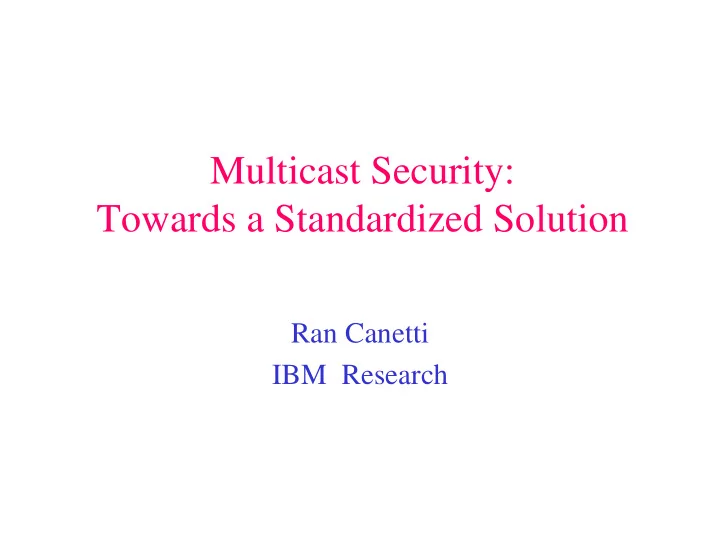

Multicast Security: Towards a Standardized Solution Ran Canetti IBM Research
In this talk: • A taxonomy of multicast security issues • Some outstanding algorithmic problems • Work at the SMuG (IRTF): – Some design principles – Overall architecture – IPSec-based host architecture (draft proposal)
Multicast communication: Whenever there are multiple recipients • Typical applications: – File and software updates – News-feeds – Video/audio broadcasts – Virtual conferences, town-hall meetings – Multiparty video games
Multicast group characteristics • Number of sources, receivers • Membership dynamics • Bandwidth and latency requirements • Duration • Physical separation (network topology and political separation)
Security requirements • Limiting access to group communication: – Long-term secrecy – Ephemeral access restriction • Authentication: – Group – Source • Anonymity • Availability ( against denial of service attacks)
Trust issues • Trust in centralized group manager – To generate keys properly – To distribute keys properly Ways to reduce trust requirements: • Distribute center’s tasks • Use hierarchic control structure • Trust in group members – To not impersonate other group members – To not re-distribute keys
Performance parameters of security solutions • Time to verify and decrypt data • Time to authenticate and encrypt data • Communication bandwidth overhead • Key set-up and refreshment overhead • Group set-up and member enrollment time
An outstanding problem: Source authentication • MACing with shared key is not enough • Signing every data packet is unrealistic • Possible solutions: – Sign every n th packet (and hash in between) [GR, R, WL, …] – MAC with multiple keys (Receivers have different subsets of keys) [CGIMNP]
An outstanding problem: Membership revocation • To hide future communication from a leaving member, need to change group key. • How to send new group key to everyone except the leaving member ? – Can use a data structure that gives O (log n ) communication (and O ( n ) memory for center) [WHA, WGL]. – Is it possible to do better? (some improvements & bounds in [CGIMNP,CMN])
Wallner’s tree k k 0 k 00 k 001
Work done at Secure Multicast Group (SMuG) • of the Internet Research Task Force (IRTF) http://ipmulticast.com/community/smug
A first-cut scenario: • One-to-many communication • Medium to large groups (10-100K) • Centralized group management • No trust in group members • Need source authentication, ephemeral encryption • Dynamic membership
A basic design principle: • Divorce security from the routing method. This implies: – Data packets are routed without change (e.g., using any IP multicast, reliable multicast, or even TCP) – All crypto is done at endpoints (No re-encryption of data en-route!) – Possible exceptions: Firewalls, political barriers
More design guidelines • Separate key management from data handling • Use existing components when possible (SSL, IPSec) • Minimize changes to OS kernel • Maintain ability to plug-in different crypto algorithms
Global architecture (I): Control communication Data communication
Global architecture (II): Control communication Data communication
IPSec-based host architecture (proposal developed at IBM Research) Control API Data API Multicast Internet Source Authentication Key Exchange Module Multicast Secu- App. space rity Association OS kernel AH/ESP (IPSEC) Line Line (group controller) (group members)
Control API Data API Multicast Internet Source Authentication Key Exchange Module Multicast Secu- App. space rity Association OS kernel AH/ESP (IPSEC) Line Line IPSEC transforms (AH/ESP): -Data encryption with group key -Group authentication with group key -Operates on individual packets (No state across packets)
Control API Data API Multicast Internet Source Authentication Key Exchange Module Multicast Secu- App. space rity Association OS kernel AH/ESP (IPSEC) Line Line SAM Signing data efficiently requires: -Signing data in large chunks -Keeping state across packets Therefore, SAM is in transport layer (UDP), operates on UDP frames.
Control API Data API Multicast Internet Source Authentication Key Exchange Module Multicast Secu- App. space rity Association OS kernel AH/ESP (IPSEC) Line Line MSA is a database that holds: - IPSEC SA for AH/ESP (group key, algorithms, group address, etc.) - Information for SAM (Signing/verification keys, algorithms, etc.) -MSA is periodically updated by MIKE.
Control API Data API Multicast Internet Source Authentication Key Exchange Module Multicast Secu- App. space rity Association OS kernel AH/ESP (IPSEC) Line Line MIKE: - Invoked by API to join/leave multicast group. Join/leave interaction done via standard point-to-point secure connection (such as IPSec, SSL) with the center. - Receives key updates from controller and updates MSA -Key updates assume a “reliable multicast shim” (Can be implemented by any RM protocol /TCP)
Conclusion • Security is a central concern in almost any multicast application on the Internet. • Have made initial steps towards designing a standardized solution. • Much more work to be done...
Recommend
More recommend